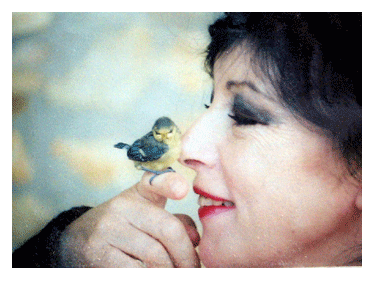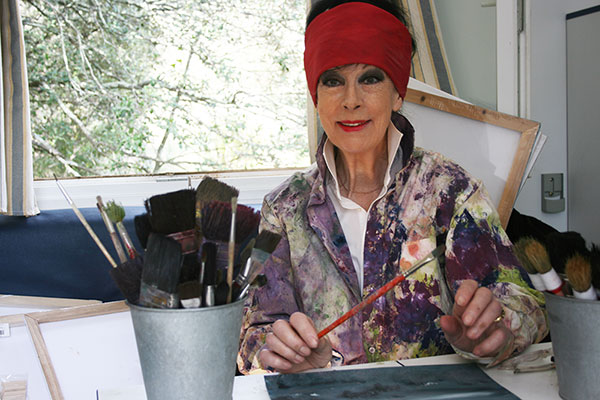About Su ...

The works of Susan Goddard are broadly speaking in the abstract expressionist tradition and the influences include such as:
- Arshile Gorky
- Jackson Pollock
- Robert Motherwell
- Barnett Newman
- Willem de Kooning
- Mark Rothko
- Helen Frankenthaler
The last name on the list, an American artist who was born in 1928, is important because Su salutes her as a major inspiration and influence. Abstract expressionism is a mode of externalising internal feelings and ideas in forms whose logic is not totally determined by the constraining facts of nature, but involves concurrently the artist's overall visionary imagination and expression of experience. Often these images are pre-existent in the mind before the artist takes up the brush, but on many occasions they only come into being once the production of the physical painting gets underway.
Recent Paintings
 The history of twentieth-century art is littered with 'isms': Vorticism, Surrealism, Super Realism, Minimalism, Constructivism, Expressionism, Abstract Expressionism, Representationalism. The labels are useful and convenient for defining the paintings, and patrons, dealers, scholars, connoisseurs and purchasers seem quite unable to do without them. Products have to have contexts, mapped-out provenances and taxonomic identification, it seems, before anyone is prepared to criticise, understand, buy and even simply enjoy. The commodity status, especially of the concrete visual arts, exacerbates these tendencies; these labels are with us, they won't go away, even should one wish it.
The history of twentieth-century art is littered with 'isms': Vorticism, Surrealism, Super Realism, Minimalism, Constructivism, Expressionism, Abstract Expressionism, Representationalism. The labels are useful and convenient for defining the paintings, and patrons, dealers, scholars, connoisseurs and purchasers seem quite unable to do without them. Products have to have contexts, mapped-out provenances and taxonomic identification, it seems, before anyone is prepared to criticise, understand, buy and even simply enjoy. The commodity status, especially of the concrete visual arts, exacerbates these tendencies; these labels are with us, they won't go away, even should one wish it.
To clear the ground then, to get the knob tuned as clearly as possible to the precise point on the aesthetic wave-band, one can say that these works of Susan Goddard are abstract expressionist, or within sight of traditions which have been regarded as abstract expressionist, frequently the expressionism being inferred in terms of pure abstraction. To say this is to conjure enough ghosts to make an All Souls aesthetic soirée seem disconcertingly puzzling and overcrowded:
Arshile Gorky, Jackson Pollock, Robert Motherwell, Barnett Newman, Willem de Kooning, Mark Rothko and Helen Frankenthaler.
These are some of the names, and the last one on the list, an American artist who was born in 1928, is important because Susan salutes her as an inspiration and an influence. Broadly, abstract expressionism is a mode of externalising internal feelings and ideas in forms whose logic is determined not by the constraining facts of phenomenal nature, but by a more mental repertoire of images. Often these images are pre-existent in the mind before the artist takes up the brush, but on many occasions they only come into being once the production of the physical painting gets underway. Something like this was the case with Jackson Pollock.
At every point in this brief attempt to sum up abstract expressionism there are problems, paradoxes and contradictions, since every artist has to make a difficult and fluctuating relationship between his or her mental world and what is objectively outside. Often this relationship will involve tentative compromise.
Susan's work maintains a tensely poised balance between the inner world (which must necessarily be private) and the outer, but it is clear that in her case the treasure-house of natural, organic form is saliently influential. It's not that these fonts are reproduced literally. A transformative process has been underway, as if the human intelligence were capable of generating shapes analogous to natural forms. Many of these paintings were produced in a studio deep in a Dordogne wood, and the insistent presence of the natural shapes could not be entirely avoided. Nature often seems to be engaged in obsessive acts of printing-lichens and fossils on stone, worm tracks in bark, wind tracks on water, and endless cameo effects of light on dark and dark on light - a species of expression which in 'A Winter's Tale' Dylan Thomas called 'calligraphy of the old leaves'. Another presence of nature felt in these paintings, but not usually directly seen, is the human body, which is an element in Susan's aesthetic both as observed visual presences and tactile presences influenced by her ballet training. Also available is the rich repertoire of man-made, mind-made shapes, which any artist must live to a great or lesser degree, shapes pre-existing in the physical world, and coming independently into being in the mind and on the canvas and the paper. Often these will be severely geometrical and austere. Susan's sustained interest in architecture, including the planning of interiors, forms a reservoir from which to draw, and also the archaeological illustrations she has been producing for the Ashmolean Museum and the British Museum. Archaeological artefacts of this kind inevitably invite responses which range from the historical and associative through to the aesthetic 'pure form' modes.
What is remarkable about the works on view is that they are all in watercolour. Traditionally, abstract expressionist artists have been high-profile votaries of oil, often involved in macho drama, melodrama even. Watercolour, on the other hand, is often supposed to be tight, limited, highly controlled. There have been exciting attempts to enlarge the scope of watercolours - one thinks of Kandinsky and Klee - but generally the little squares of paint in the neat black boxes have invited caution and reticence. It is at once obvious that nothing like this syndrome is characteristic of Susan Goddard's work. It is challengingly expressive of mental excitement, mental turmoil even, and yet, like much of the best abstract expressionism of the century, it makes no bones about drawing inspiration from what the medium itself can offer - the paper, the pigment, the water, which come together with a species of volition independent of the artist, yet also control label by the artist. The brush makes quasi wind-tracks on the water charged with pigment. These paintings are mostly done at a single intense sitting, or rather standing, because the controlled tension that goes into production cannot be managed in the traditional seated posture of the water-colourist. Looking at these works one is continually reminded of some lines by the seventeenth-century poet John Dryden:
This is a child of care and not of chance,
No atoms casually hurled
Could e'er produce so beautiful a world.
©
2008-2025 All images and text copyright Su Goddard
Website developed by 2m